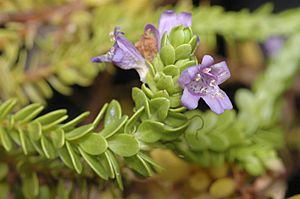Wongan eremophila facts for kids
Quick facts for kids Wongan eremophila |
|
|---|---|
 |
|
| Conservation status | |
| Scientific classification | |
| Genus: |
Eremophila (plant)
|
| Species: |
ternifolia
|
The Wongan eremophila (scientific name: Eremophila ternifolia) is a special kind of flowering plant. It belongs to the figwort family, called Scrophulariaceae. This plant is only found in Western Australia, meaning it's endemic there. It's a small, bushy plant with many branches, short, pointy leaves, and pretty lilac or mauve flowers.
Contents
What Does the Wongan Eremophila Look Like?
Size and Shape
The Wongan eremophila is a spreading, aromatic shrub. It has many branches and usually grows to be about 30 to 50 centimeters (about 12 to 20 inches) tall. Its branches are covered in tiny hairs.
Leaves and Flowers
The leaves of this plant are arranged in groups of three, called whorls. They are clustered close together at the ends of the branches. Each leaf is shaped like a narrow oval, about 6 to 11 millimeters long and 2.5 to 4 millimeters wide. They are smooth and light green, but sometimes have a reddish-brown color on the underside.
The flowers grow one by one where the leaves meet the stem. They don't have a stalk. Each flower has 4 or 5 green to reddish-brown, hairy sepals. The petals are joined together at the bottom to form a tube, about 8 to 10 millimeters long. The outside of the flower tube is lilac or mauve. Inside, it's white with purple spots. The outside of the tube and its tips are hairy. The inside of the tube is full of long, soft hairs.
Stamens and Fruits
Inside the flower tube, there are four stamens (the parts that make pollen). They are completely hidden inside the tube. The Wongan eremophila flowers mostly in October and November. After flowering, it produces small, dry, woody fruits. These fruits are oval-shaped with a pointed end, about 2 to 3 millimeters long, and covered in hairs.
How Did It Get Its Name?
This plant was first officially described in 1982 by a scientist named Robert Chinnock. The second part of its scientific name, ternifolia, comes from two Latin words. Terni means "in threes," and folia means "leaves." This name refers to how the leaves are arranged in groups of three.
Where Does the Wongan Eremophila Live?
This special plant only grows in the Wongan Hills area of Western Australia. It likes rocky places. This area is part of a larger region called the Avon Wheatbelt.
Is the Wongan Eremophila in Danger?
Conservation Status
Yes, the Wongan eremophila is considered a rare and important plant. The Department of Environment and Conservation (Western Australia) lists it as "Threatened Flora." This means it's a very rare plant that needs protection. The Australian government also lists it as "Endangered" under its laws. This means it's at high risk of disappearing from the wild.
Population Numbers
Surveys done between 1999 and 2001 found that there were only about 1381 Wongan eremophila plants left in total. This low number shows why it's so important to protect this unique species.
Growing Wongan Eremophila in Gardens
A Great Garden Plant
The Wongan eremophila can be a beautiful addition to a garden. It grows into a dense, round shape with a flat top, making it look very ornamental. Some plants in gardens have lived for over 25 years! Its lilac flowers and leaves, which sometimes turn reddish-brown, are very attractive.
Care and Conditions
It's usually grown from cuttings. This shrub grows well in most types of soil. It prefers a sunny or partly shaded spot. The Wongan eremophila is also very tough. It can handle dry periods (drought tolerant) and is very good at surviving frost.


